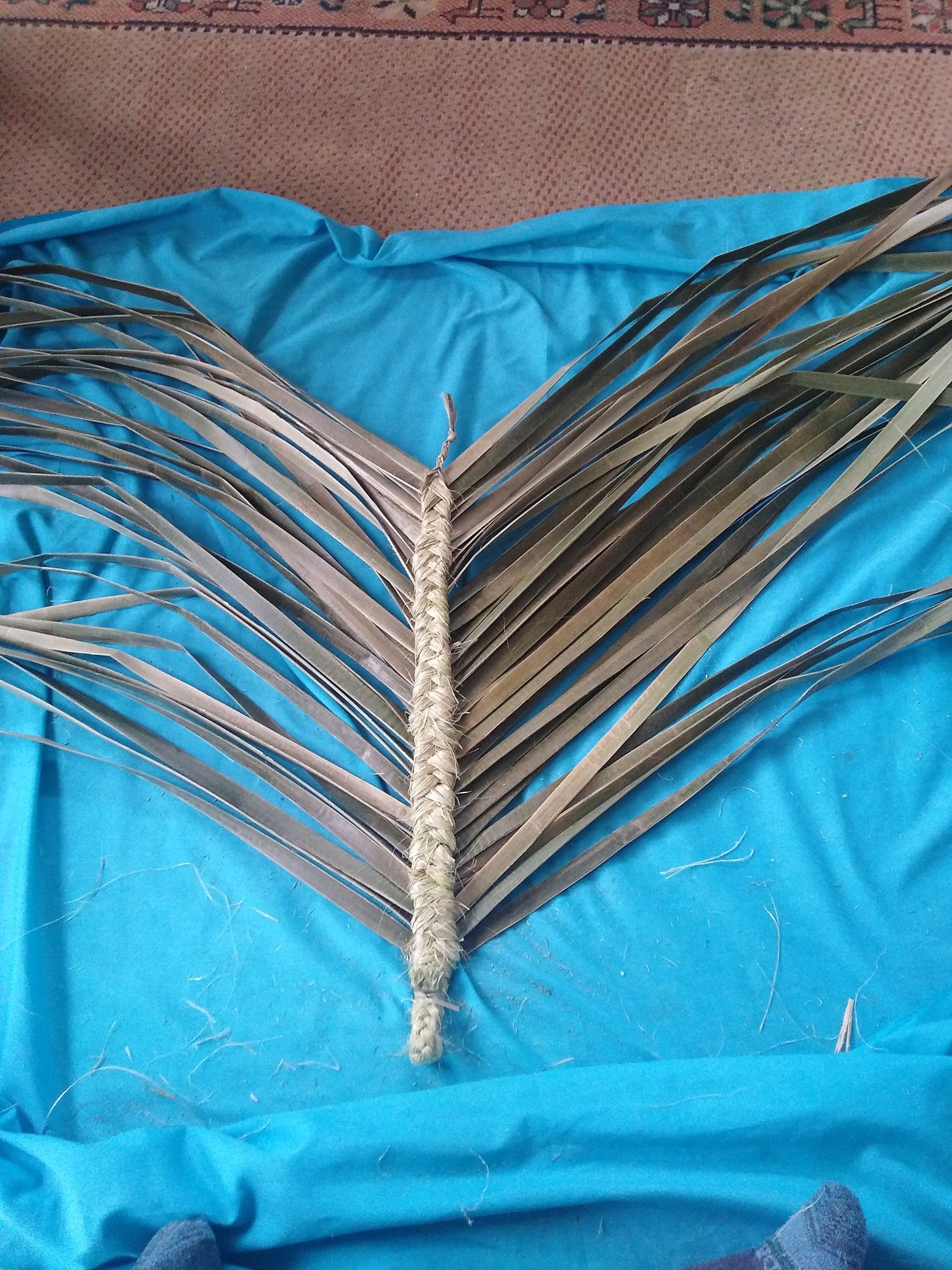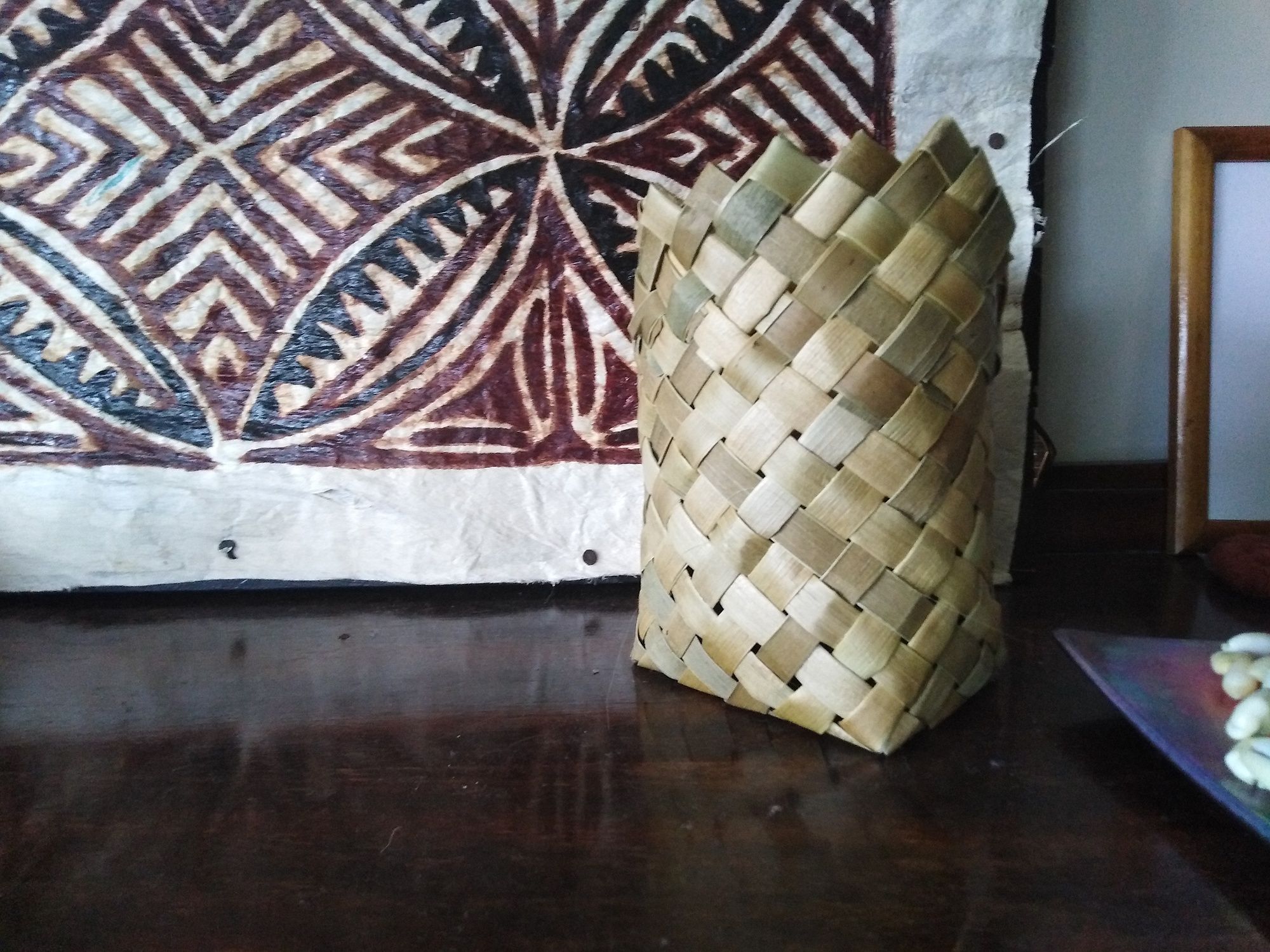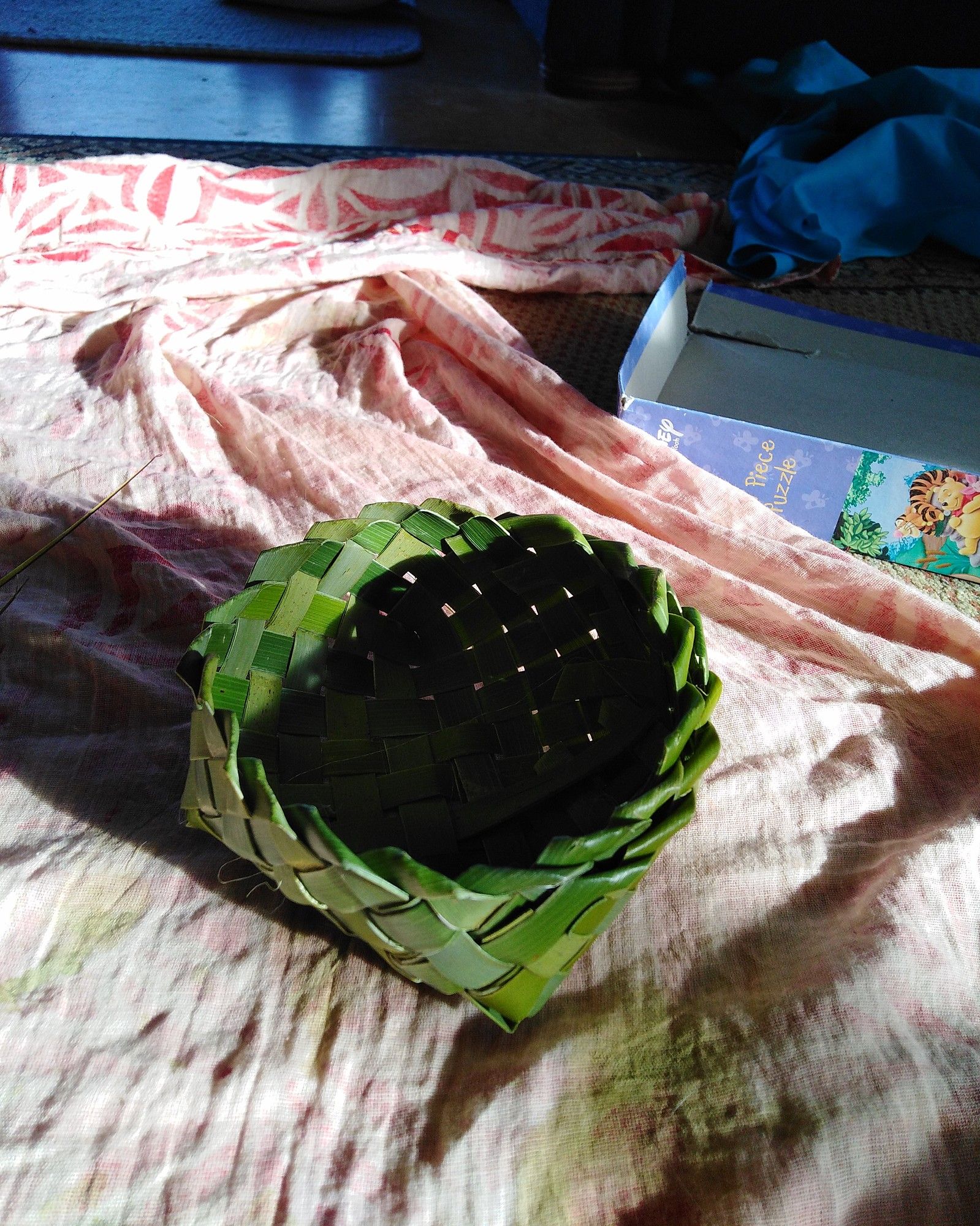The Shared Whakapapa of Raranga
Stacey Kokaua reconnects to her māmā, a Cook Island weaver and tīvaivai maker, through the raranga traditions of mana whenua.
During the March lockdown, I begin learning raranga online. I see no future for me and sourdough. And to help people cope with Covid-19, master weaver Veranoa Hetet is offering the course for free.
The lessons begin with kono, a small container with a square base. What I weave is quite good. This surprises me. I’m no good at crafty things – too many small details and fidgety techniques. I love to dig and bang and climb and drag. My fingers are clumsy. But here is this little container of harakeke, of neat green interlocking squares, that those same hands have made.
I know it’s my māmā, my father’s mother. She was a proficient weaver, sewer, tīvaivai maker, cook and housekeeper. She spoke four languages, taught herself English by reading the bible, excelled at anything she chose to do. The same woman tried to teach me everything she knew.
There is a photo of us at a family reunion. We’re a Cook Island family, so we hire a camping ground for the event. We sit in the hall, on stackable chairs either side of one of those old hall tables – wooden with metal legs that can be folded out. On the table is the raranga. Māmā’s hands are busy working the leaves into a mat, and I look off into the distance, my hands resting on my lap. I sigh. I am 12 years old and resent the fact that I have to learn yet another craft, yet another example of women’s work. Just because I’m a girl, the eldest in my family.
Twenty-five years later, I wish I could be at that table again. If I could, I would take my māmā’s hand and say, “Meitaki ma‘ata e Māmā. Thank you for teaching me raranga and for sharing your knowledge with me, your mokopuna.” But I can’t. And hanging about the house for six weeks has me thinking about things like this.
Stacey’s first kono.
Meitaki ma‘ata e Māmā. Thank you for teaching me raranga
When I weave, I feel her around me. It’s as if she’s sitting right there, watching, willing me to get it right, patiently working through my missteps. She’s not unhappy that I’m weaving but definitely sees room for improvement. And she knows me. As a student, I can be lazy and I lack attention to detail. So as I learn how to make kono, I notice I am making errors and think, oh well, I’ll just see how it goes.
But then I hear something, less than a whisper, like a memory, “You’ll regret that. You should restart.”Sometimes I listen. Sometimes I don’t. But Māmā is always proven right.
*
There’s a complete experience to raranga that absorbs and relaxes me. The smell of the harakeke, the process of cutting, then clipping, then stripping, then laying it out for weaving. There is a mathematical symmetry to the construction that focuses on pleasant numbers, often multiples of four. As a reward for your work, you produce something that can be used or gifted or displayed. My mind is crowded at the best of times, but 2020 is an experiential overload. Raranga provides order, a way to keep my hands busy, and a satisfying end product.
When I run out of harakeke around my place, I go to the local playcentre and negotiate. My service (tidying up all of their harakeke) in exchange for rau. The resident of the playcentre is a young mother, Connagh. She is mana whenua and lives a ten-minute drive from the local marae, like her sisters, her mother, her grandmother, her great-grandmother (possibly any woman connected to her by blood, but those are the ones I’ve met). I am attempting to trim up the playcentre harakeke when her taua, Moana, arrives. Connagh has already told me about the harakeke growing around her taua’s home so I ask Moana if she could give me some pointers on what I should be doing.
This harakeke turns out to be very old and long neglected. Like the harakeke around my place, it blends into the surrounding area and is rendered invisible. I’ll admit that my child has been at this playcentre for three years and I have never looked closely at these plants that line the path to the front door. So what I think is going to be a quick chat with Moana about tips for cutting flax turns into a session about everything that can go wrong with harakeke. There’s rot, there’s decay, harakeke so crowded that there is hardly any rau, just long, hard stalks of take. Bugs have eaten holes in the rau, and there are eggs at the base of some plants.
Flax growing near Pancake Rocks, Punakaiki. Photo credit: Brian, Flickr.
They will need to be burnt.
A tree is growing in the centre of one plant, an invasive vine grows through another. I thought it would take a couple of sessions, but I end up working on them for six days over three weeks. There is nothing I can use.
But next year there will be.
The old practice was to return anything you cut off to the base of the plant. People now avoid this, as putting the leaves at the base of the plant provides the perfect home for pests, specifically the light-sensitive caterpillars of two native moths that feed on the rau at night. And in the case of these harakeke, the amount I remove equates to a pile the size of a full-grown plant. But as I get everyone to help me stack the decayed brown rau, I consider that this type of sporadic maintenance would not have been practised in a world where harakeke was the main textile. In pre-colonial Māori society, where harakeke was used for everything – rope, clothing, containers, baskets, mats and more – surely they would not have planted harakeke ornamentally? Only tending it when it was wasting away?
I ask Moana to look at the final work, worried that I have been too aggressive, but she approves. The new rau stand tall, the brown removed to reveal the green gloss of the leaf and muted grey underside. They sway. It must be nice to feel the air around you after being so crowded and clogged with water that has nowhere to drain.
By removing the decaying and diseased leaves, I have enhanced the wellbeing of these plants and in return they will grow strong and ready to use. In time. But I am left in my original position of having no harakeke to weave with. I find myself at my neighbours’, my parents’, my sisters’, my friends’ houses, making the same transaction I did with the playcentre; maintenance in exchange for rau. I now have a steady stream of weaving materials.
My neighbour, Kitty, comes to my house to weave one evening. Kitty, who is also learning, is mana whenua. I feel reluctant to overstep the boundaries. I am learning raranga in Aotearoa, after all. While I am from a culture that practices raranga, Rarotongan methods focus on the use of palm leaves. The methods that I’m learning from Veranoa are the taonga of Kitty’s people, tangata whenua o Aotearoa. But we find a sense of shared whakapapa/papa‘anga. Apparently, the design and construction process of the modern piupiu (using curled lengths of harakeke) was created around the beginning of the 20th century. Before then, piupiu were made of muka, giving them the appearance of the ‘ura skirts of the Cook Islands. Kitty and I learn how to make rourou – a small round bowl for food.
A rourou.
Nā tō rourou, nā taku rourou, ka ora ai te iwi
Veranoa says it’s an old design, brought from the Pacific. It shares the same shape as the raurau, a Rarontongan term to describe a small basket made from the coconut palm, usually used to hold food.
Nā tō rourou, nā taku rourou, ka ora ai te iwi.
I have a habit of laying out an old pāreu when we weave. That way, it’s easier to catch all of the waste and dispose of it properly. Kitty asks me if this is tikanga. I realise that I don’t know why I do this. Did Veranoa recommend this? But the use of a pāreu? It could be something I have been taught when weaving with my community. It could be both of these things.
It becomes apparent to me that learning raranga online is connecting me back to the women I grew up with – wise, fierce Cook Island women. It connects me to Aotearoa by helping me acknowledge the whakapapa I share with mana whenua. And it also changes the way I look at the environment around me. Because New Zealanders love harakeke. It’s planted in public spaces, along roads, in gardens, around farms. It’s so low maintenance, it asks so little of us. It attracts native birds, their song enhancing our sense of connectedness to this place. While it may not ask much, it does better if we don’t neglect its needs completely.
Down the streets of my neighbourhood, I see many harakeke. Some look as though they have not been tended for years. Others are haphazardly attacked to keep out of the way of a driveway or footpath. I remember Māmā Ta‘i, in Wellington, offering to help me make costumes for a performing arts group I tutored. We set off with some students into the bush around the community hall to collect a particular type of fern. She explains to the students what we are looking for:
“This is the fern. Only take the outside leaves. The centre is the baby. Either side is the māmā and the pāpā. Leave them too. They are there to look after the baby, so the plant can keep growing.”
We collect the materials and bring them back to the group so each student can learn to make their own ‘ei katu. Pāreu are laid across the table where the students work. “Auē! Who took these? This is the baby.”
Māmā Ta‘i is holding a handful of fern leaves. I can see they are a lighter shade of green. She takes them and wraps them up, they will need to be returned to the land. This is what I think about when I see local harakeke whose centre, the rito, the baby, has been hacked away to keep the plant off the road.
*
During isolation, as I think about the people I miss and the things I miss doing, I decide I will surround myself with wise, brown women, and nurture relationships that encourage me to be a better person. When the lockdown ends, I call Moana, my friend’s taua. She meets me at the pub, where we have lunch. We discuss local issues, defunding the police, systemic racism in Aotearoa, the history of mana whenua in our area. These are conversations that feed my wairua. At the end of the lunch, we go across the road to the workshop where she creates pounamu, and she brings one to me. “This is meant for you. She’s for a weaver. Her name is Ripiripi.”
And she is indeed made for a weaver. Her curved shape makes it easy to hold the flattened edge against the harakeke. I later find that while I can use her for hāpine, her particular gift is in the creation of muka. Moana has carved her unsure of where she will end up. And here she is, falling into my palm.
Stacey wearing Ripiripi.
I tear up. Firstly, I am touched by the gift. But secondly, I feel completely unworthy of it. Learning raranga online is one thing, being gifted a hand-crafted weaver’s tool made of pounamu from a wahine Māori is a very different thing. Because I know what it feels like to watch strangers stroll confidently through a cultural environment that you are bound to by blood yet leaves you terrified. I am a New Zealand-born Cook Islander with a Pākehā mother. I know the guilt, the shame and anxiety of not knowing what you should, of not being appropriately connected, the sense of failure. I was in no place to reject this gift, but I realised something in that workshop – I had better get to work on the raranga.
So I sign up for further learning with Veranoa. I open the new module and it begins with weaving kete whiri. It is good practice to gift your first piece so I begin with Moana in mind. It’s a challenging project for me that includes creating muka – this is when I discover Ripiripi’s talents. It takes more work than I expect, but I finally get to a stage where I am ready to weave. I have collected the harakeke, split the rau, produced the whenu with muka ends, done the hāpine and set them in two neat piles. I work alongside Veranoa’s busy hands as she explains the process:
What I’ve done here is … I’ve constructed a leaf … before Māori people came to Aotearoa, it’s thought that we came from a tropical place … where there were probably palm trees with large leaves like this. We got to Aotearoa … and we didn’t have those same trees … so we had to construct them.
I have my old pāreu on the floor. I look at what I’m making, the base of my kete whiri. It’s a shape I have constructed under the guidance of tangata whenua, using an ancestral practice. Ancestors who came from across Te Moana Nui a Kiva, deliberately, to settle, who sought ways they could make Aotearoa more like home. I know my work would surprise Māmā as much as it surprises me.
Look at this, I’ve woven harakeke into coconut palms.
Feature image: Stacey Kokaua's first woven coconut palm.





